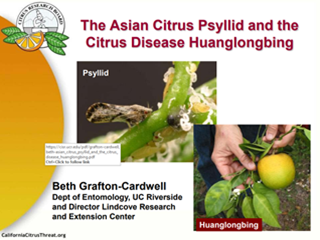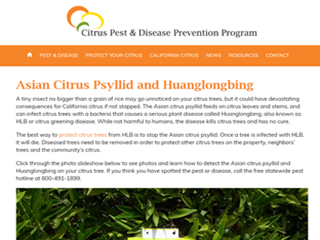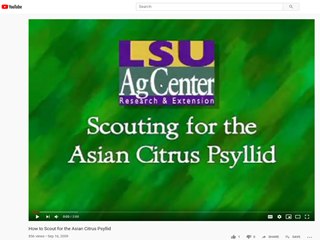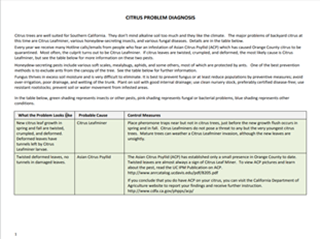
IDaids for ACP, vector of Huanglongbing
The Asian citrus psyllid (Diaphorina citri), also called the Asiatic citrus psyllid or ACP, is a notorious pest that prefers citrus and closely related plants for hosts, particularly species within the genera Citrus, Citropsis, and Murraya. ACP is tiny, with adults measuring roughly 3 mm (or 1/8 of an inch) and nymphs 0.25 – 1.5 mm, though its size is not indicative of its potential threat. It causes direct damage that results in deformed new plant growth or stem die-back, and it produces honeydew, which can induce sooty mold growth. But it causes more harm as a vector of one of the most serious and destructive citrus diseases in the world: Huanglongbing (HLB, also known as citrus greening or yellow dragon disease), caused by the bacterial pathogens Candidatus Liberibacter americanus and Candidatus Liberibacter asiaticus.
HLB is a serious disease because it reduces crop yield, renders fruit unmarketable, will eventually kill its host, and is incurable. Hosts are asymptomatic after an initial infection, sometimes for many years. Once visible symptoms appear, such as yellow shoots, mottling on leaves, and fruit that is misshapen, bitter, or remains green in spots, the pathogen is already well established. Also, symptoms may be subtle or confused with mineral deficiencies or diseases that produce similar-looking symptoms.
Studies show that HLB spreads via two pathways: by psyllid vectors or by movement of infected host material. In the U.S., host material is closely monitored and regulated, vastly restricting this pathway. To address the vector pathway, quarantine areas have been established in citrus-producing states and U.S. territories. A USDA APHIS quarantine area was recently established for ACP in Clark County, Nevada, a previously-uninfested state, indicating this pest is spreading.
Although the spread of this vector is a concern, with vigilant scouting for obvious symptoms, and close inspections to detect the pests themselves, we can work together to be proactive in protecting our citrus. Here we present a set of IDaids that support the detection and identification of the Asian citrus psyllid.
Visit Search IDaids to find identification resources for many more plant pests.
The Asian Citrus Psyllid and the Citrus Disease Huanglongbing
Citrus Research Board, United States of America
This 34-slide PowerPoint contains pertinent information and lots of explanatory photos supporting scouting and detection of the ACP, particularly in “The pest insect” (slides 2-6) and “Detect the insect” (slides 27-31) sections.
Citrus Pest & Disease Prevention Program
California Department of Food and Agriculture
The slideshow on this website dedicated to detecting and preventing the spread of the ACP and HLB has a good selection of photos clearly showing what to look for.
Scouting for the Asian Citrus Psyllid
Louisiana State University Ag Center
This short YouTube video covers symptoms and telltale signs to look for when scouting for the ACP.
Citrus Problem Diagnosis
University of California, Davis
This comparison chart is helpful for narrowing down problems in citrus trees, including ACP. It describes the pests and the symptoms caused by pests, diseases, and other conditions, and how to control them.



